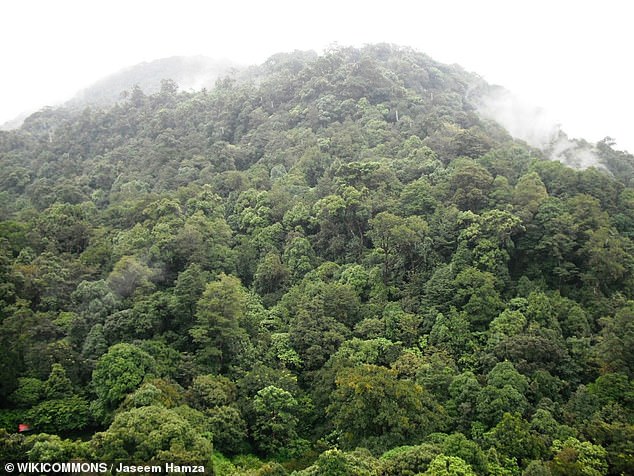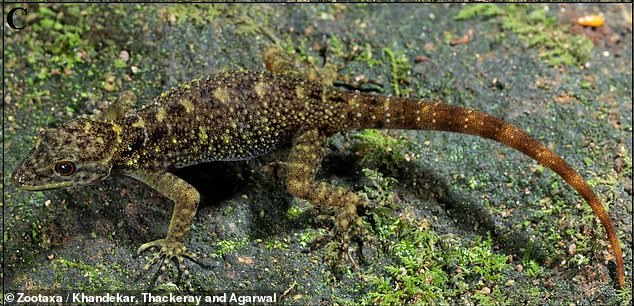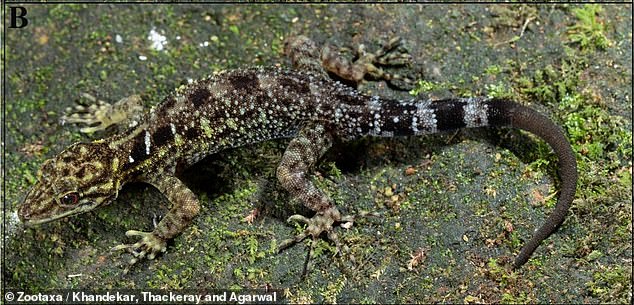New scaly creature with long fingers and red eyes discovered in India’s 1,200-meter high-altitude forest
A scaly creature with long fingers and red eyes discovered in the evergreen forests of India has been confirmed as a new species.
Biologists carried out DNA analysis on an unusually large gecko they found almost 1,400 meters above sea level on the Valparai Plateau in the south-west of the country.
The gecko – now officially called the ‘Valparai dwarf gecko’ – lives almost exclusively in ‘boulder habitats in evergreen forests in Tenkasi’, a region that is home to some of India’s most important spiritual and cultural sites.
But the team also found four brand new species of geckos, all from the same common ancestor, and each in their own little habitat high in the tropical evergreen forests of India.
New DNA analysis has confirmed that an unusually large red-eyed gecko (pictured) – found in a high-altitude evergreen forest in India – is a genuine new species

Above is an example of India’s evergreen forests in the region where the new gecko species was found. This mist-shrouded forest is located in the Silent Valley National Park – one of India’s last undisturbed stretches of the southwestern Ghats with its high-altitude tropical evergreen forests
The phenomenon whereby a species evolves to fit a very small niche in an equally small habitat is called ‘extreme micro-endemism’.
And all 23 known species of this form of gecko are known to be equally homebound to their small local ecosystem.
The new Valparai dwarf geckos were classified as large for this lizard family, but only grow to about 5 inches (12.5 cm) in length, according to the new study published in June in the peer-reviewed journal Zootaxa.
The Valparai dwarf was first identified as a new species due to its unique red eyes, its color and scale pattern, the position of its many spines and the long fingers visible on its claws.
But on a less visible, microscopic level, DNA testing of the Valparai dwarf specimens showed that the lizards differed genetically by more than eight percent from their fellow dwarf geckos.

The female specimen of the Valparai dwarf appeared “much darker overall,” with “less noticeable yellow coloration,” according to the researchers. The female also appeared to have an orange-brown tail (photo above)

One male specimen of the Valparai dwarf gecko (pictured above) had a dull brown portion of the tail where the appendage had been cut off and regenerated
The geckos were found in a cave outside Tenkasi, located on rocks near a road, one of the region’s many temples and a tea plantation.
It is estimated that the lizard’s habitat spans an elevation between 3,900 and 4,600 feet.
The Valparai dwarf gecko samples showed surprising color variations within just this one new species.
All three Valparai specimens have a ‘tan’ color, but the two males had darker ‘black and white’ areas along their tails.
One male dwarf gecko specimen had its sides peppered with bright yellow spots, while the other had a dull brown portion of the tail where the appendage had been cut off and later regenerated or grown back.
The female specimen of the Valparai dwarf appeared “much darker overall,” with “less noticeable yellow coloration,” according to the researchers. The female also appeared to have an orange-brown tail.
The study’s three co-authors, who worked with the Thackeray Wildlife Foundation and India’s Shivaji University, also identified four new and closely related dwarf gecko species.
This new species, named the Agamalai dwarf gecko, the Anaimalai dwarf gecko, Anuradha’s dwarf gecko and the Tenkasi dwarf gecko, had a genetic divergence of somewhere between 5.4 and 2.3 percent from each other, the researchers said.
In keeping with all these hyper-local and rare gecko species, the research team also noted that there were three more ‘non-sister species’ of geckos, in addition to the 23 known species, that lived along a straight line within a mile of each other. at the protected Anaimalai Tiger Reserve on the Valparai Plateau.
